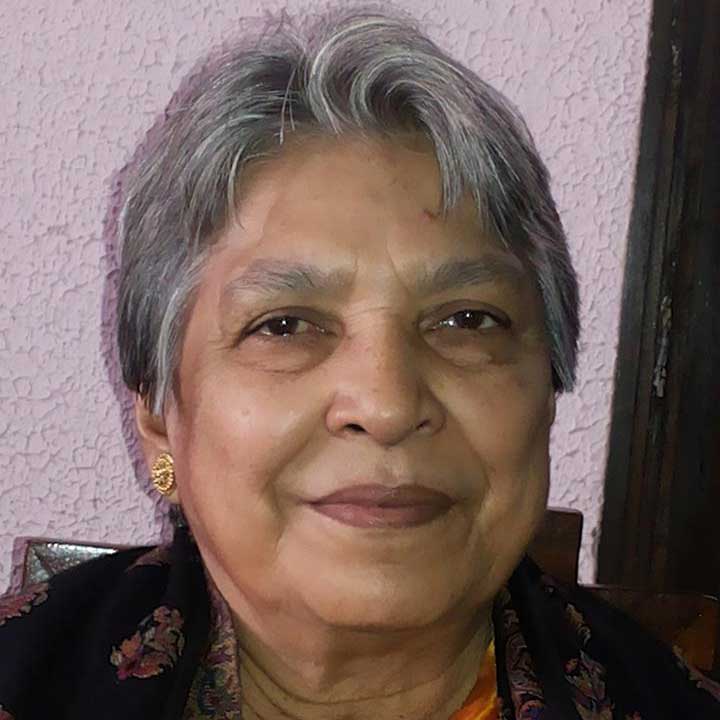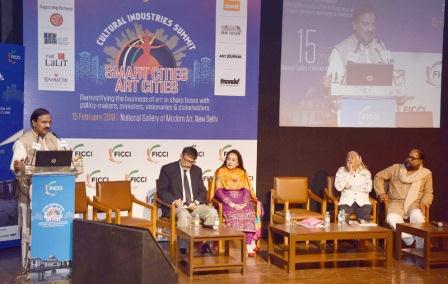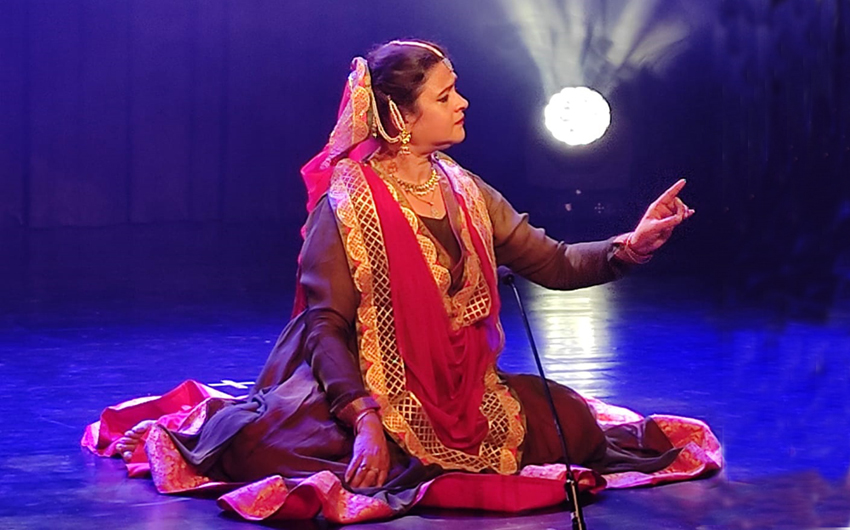With the spectrum of COVID 19 looming high in the horizon artists have found a way of expressing their aesthetic capabilities through virtual programmes.
New York based Arts from India presented Navarasa –a virtual classical dance concert on the nine rasas eternal to mankind.
The nine rasas exist within all human beings. Stories may emerge from one’s own experiences to showcase rasas/emotions. However, the rich body of literature and puranic stories that we have inherited are more easily identifiable and so are commonly used to showcase rasas.
It was interesting to watch the exploration of all the rasas/emotions that exist within us and in the universe through well-known stories.
 Vijaylakshmi a renowned Mohiniattam dancer performed a Jayadeva’s astapadi from Geeta Govinda ‘Haririha Mughdha Badhu Nikare’ in raag Mohana and Chempada talam, needless to say in Sopanam music as prevalent in the temples of Kerala. She dealt with Shringara rasa which is the ultimate rasa. The purpose of life is to experience this divine emotion of which, experiencing bhakti sringar between soul and super soul is of the highest order of love. Vijaylakshmi’s torso moved gracefully in circular patterns in well-coordinated movements imbibed meticulously from her guru/mother Bharati Shivaji. Eyebrow movements accompanied with suitable love expressions explored the love of the gopis for the sandalwood smeared body of their istadevata-Keshava. She displayed the highest example of transcendental love.
Vijaylakshmi a renowned Mohiniattam dancer performed a Jayadeva’s astapadi from Geeta Govinda ‘Haririha Mughdha Badhu Nikare’ in raag Mohana and Chempada talam, needless to say in Sopanam music as prevalent in the temples of Kerala. She dealt with Shringara rasa which is the ultimate rasa. The purpose of life is to experience this divine emotion of which, experiencing bhakti sringar between soul and super soul is of the highest order of love. Vijaylakshmi’s torso moved gracefully in circular patterns in well-coordinated movements imbibed meticulously from her guru/mother Bharati Shivaji. Eyebrow movements accompanied with suitable love expressions explored the love of the gopis for the sandalwood smeared body of their istadevata-Keshava. She displayed the highest example of transcendental love.
Hasya rasa is all about humour and laughter and mirth, signifying contentment and happiness with a tinge of sarcasm. Bharatnatyam dancer, Kasi Aysola trained by Vijay Prakash and Mythily Prakash and who has accompanied many a performer to the likes of Mythily Prakash, Rama Vaidyanathan and others as a nattuvanar, happily explored this rasa from two selected pieces by Dharmapuri Subbaraya and Subramaniam Bharati.
 It was Manipuri practitioner Sinam Basu Singh’s role to portray Karuna rasa, which is a state of sadness that was expressed through Krishna Kainarabi Yasoda ( separation of Krishna from her beloved mother Yasoda) performed to the composition Guru N.Tiken Singh, while the dance was composed by Guru N.Amusana Devi to taal tanchap of 8 matra. The pangs of mother Yasoda’s sufferings through body-language, when son Krishna had left Braja for Vrindavan opened up before our eyes. An object reminded Yasoda of his absence. A boy farmer –Rakhal balak-clad the way her son used to be, made her lose her emotional balance. She was overtaken by Karuna rasa.
It was Manipuri practitioner Sinam Basu Singh’s role to portray Karuna rasa, which is a state of sadness that was expressed through Krishna Kainarabi Yasoda ( separation of Krishna from her beloved mother Yasoda) performed to the composition Guru N.Tiken Singh, while the dance was composed by Guru N.Amusana Devi to taal tanchap of 8 matra. The pangs of mother Yasoda’s sufferings through body-language, when son Krishna had left Braja for Vrindavan opened up before our eyes. An object reminded Yasoda of his absence. A boy farmer –Rakhal balak-clad the way her son used to be, made her lose her emotional balance. She was overtaken by Karuna rasa.
In her thoughts, she reached out to him and said that the cows are not grazing, neither are the peacocks dancing as they are all sorrowing. The Yamuna has stopped flowing. Her life has become unbearable. Sinam Basu epitomised Yasoda’s sorrow in the subtle aesthetic body language of Manipuri. He captured people’s heart.
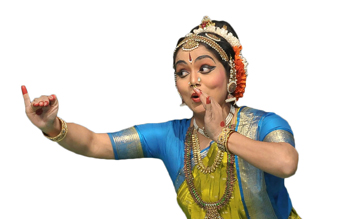 Kuchipudi dancer Srimayee Vempati from Kuchipudi Art Academy, Chennai, explored veer rasa by adorning herself in the garb of Shiva in his roudrarupa, when he had heard that Dakshayani had immolated herself in her father Daksha’s house for insulting her husband Shiva. Shiva at that point wreaked havoc in the three worlds with his Raudra Tandava. Srimayi Vempati a worthy disciple and daughter-in-law of Vempati Chinna Satyam was at her best in this excerpt from Haravilasam of her guru. It was indeed an interesting development in a form which earlier had men impersonate women. Here a woman was in the role of Shiva.
Kuchipudi dancer Srimayee Vempati from Kuchipudi Art Academy, Chennai, explored veer rasa by adorning herself in the garb of Shiva in his roudrarupa, when he had heard that Dakshayani had immolated herself in her father Daksha’s house for insulting her husband Shiva. Shiva at that point wreaked havoc in the three worlds with his Raudra Tandava. Srimayi Vempati a worthy disciple and daughter-in-law of Vempati Chinna Satyam was at her best in this excerpt from Haravilasam of her guru. It was indeed an interesting development in a form which earlier had men impersonate women. Here a woman was in the role of Shiva.
Daughters-in-law of famous gurus’ seem to have taken their respective forms to great heights. To Odissi performer Sujata Mohapatra her guru, Guru Kelucharan Mohapatra is divinity incarnate. Groomed and trained by him to be what she is today, the emotion apportioned to her could only make her think of Purushottam Rama, who in her esteem is ‘Shreshshtha Nayak’ and hence his character as a brave warrior came to her mind when she was asked to portray Veer rasa. Rama was fearless and the episode she chose to perform was his annihilation of the invincible. Ravana whose ‘tapas’ had earned him the boon of eternal life was struck at his naval –the only vulnerable part of his body. Rama came alive on stage with Sujata wielding the bow and striking at his foe with an arrow in hand in dance movements. With her foundation in Odissi Sujata took to the character of Rama with the utmost ease. Her posture as Rama was indescribably perfect just as her other movements were. She stole my heart.
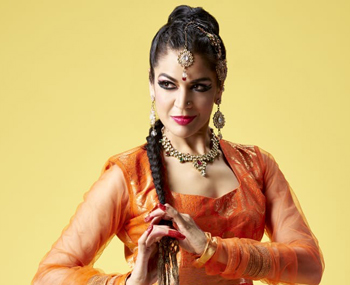 Moods of ‘Bhivatsa rasa’ by Kathak dancer Rachna Nivas left much to be desired. The portrayal of Soorpanaka’s mutilation of her face by the ‘cowardly act’ of the Suryavansh brothers was a perfect choice for this rasa, while the abhinaya could have been more pronounced disgust.
Moods of ‘Bhivatsa rasa’ by Kathak dancer Rachna Nivas left much to be desired. The portrayal of Soorpanaka’s mutilation of her face by the ‘cowardly act’ of the Suryavansh brothers was a perfect choice for this rasa, while the abhinaya could have been more pronounced disgust.
Stellar performer Anita Sharma, a disciple of Sattriya doyen Jatin Goswami, used episodes from Krishna’s life –mother Yasoda’s awe in getting a glimpse of the universe in when child Krishna opens his mouth; demoness Putana’s deliverance by baby Krishna’s suck and other stories of Gokul-to display fascination and mystery of adbhuta rasa. Her awe for the feats of Krishna as well as for Mahapurush Shrimad Shankaradeva-an Assamese polymath who lived in the 15th 16th century-a versatile genius saint-poet, who was instrumental in making what Assam is culturally and socially today. Adbhuta rasa was awesomely expressed.
 Kathakali dancer Prabal Gupta –a handpicked solo performer in the making-specializing in both stree-vesham and purush vesham; the curator of this virtual programme-had to search heaven and earth to find a master in Guru Sadanam Balakrishnan to lead him on in fulfilling his dream and passion. It was not just a chanced happening that a Bengali boy from the lanes of Dhakuria to be on such an arduous journey, had it not been predestined. Trained and moulded by this great guru he has been scaling new heights every day. For this virtual programme viewers found him journeying through bhayanak rasa through the role of Lady Macbeth, suffering from the disease called ambition. Prabal’s abhinaya projecting, “All the perfumes of Arabia will not sweeten this little hand”, was petrifying. Smelling blood even when asleep to ultimately cause a mental collapse and drop-down lifelessly was the quiet that shanta ras was made up of. Prabal Gupta displayed what it is to push boundaries. This Shakesperean concept was translated to Sanskrit by Shankar Rajaraman. The music composition was by Sadanam Sivadas.
Kathakali dancer Prabal Gupta –a handpicked solo performer in the making-specializing in both stree-vesham and purush vesham; the curator of this virtual programme-had to search heaven and earth to find a master in Guru Sadanam Balakrishnan to lead him on in fulfilling his dream and passion. It was not just a chanced happening that a Bengali boy from the lanes of Dhakuria to be on such an arduous journey, had it not been predestined. Trained and moulded by this great guru he has been scaling new heights every day. For this virtual programme viewers found him journeying through bhayanak rasa through the role of Lady Macbeth, suffering from the disease called ambition. Prabal’s abhinaya projecting, “All the perfumes of Arabia will not sweeten this little hand”, was petrifying. Smelling blood even when asleep to ultimately cause a mental collapse and drop-down lifelessly was the quiet that shanta ras was made up of. Prabal Gupta displayed what it is to push boundaries. This Shakesperean concept was translated to Sanskrit by Shankar Rajaraman. The music composition was by Sadanam Sivadas.
New York based Leena Sukumaran’s- the co-curator of INDO AMERICAN ARTS COUNCIL- questions to Prabal Gupta gave the audience a peep into what toil went in to make this production, which was so close to his heart.




